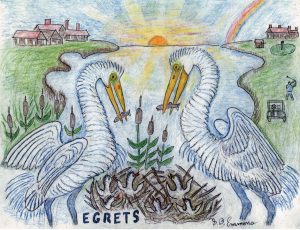My most recent afternoon ritual for bird watching walk took me down Reservation Road to the point at the end of the Mattapoisett Peninsula. It leads past the Golf Course of the same name toward a residential landmark of the King estate, and now the YMCA where my daughter teaches pre-school. The golf course is a typical links lay out bordering many holes of an extensive marsh and wading bird paradise for Great Blue Herons, Egrets, and Bitterns. I just happened to bring my clubs along to make my afternoon entertaining as well as educational.
When the author Mark Twain was asked about his golf game, he said, “Most often, it is a good walk spoiled.” Today, however, many golf courses even in metropolitan areas are an oasis of open land for wildlife and a natural mecca for bird watchers. The Reservation Golf Course is no exception. After teeing off from the clubhouse on the first hole, my second shot of a fairway wood landed me close to the edge of the wetland with a wide expanse panorama with eye-catching solitary white images.
The Great Egret has a high-profile image, almost 4 feet high, with a 5-foot wing span, a curved neck with a long wispy white plume that trails from the back and neck as in my drawing (viewable online). They are spectacular nuptial feathers called aigrettes. This ethereal decoration for preening and breeding caused the Egret to be hunted almost to extinction for ladies’ fashions. One ounce of aigrette of an Egret sold for $32, which at the turn of the nineteenth century was double the price of gold.
The feather market trade ended with the passage of the Migratory Bird Act and later publication of Silent Spring by Rachel Carson prohibited pesticides and chemicals rendering egg shells too thin to hatch. Both parents together brood and feed the young as shown, usually five or six to start but dwindling down to three or four from nest robbing by Great Horned Owls and crows. The larger young are also known to eat the smaller ones.
They grow long black legs used as rudders for flying and wading to stand motionless in shallows to fiercely strike with a long bill for fish, shrimp, or worms. The species of Snowy Egret is smaller but tall as statuesque as an avian ballerina with yellow feet, called golden slippers, used to stir up prey in shallow waters. An hour before sunset, Egrets leave the marsh and head for higher ground to gather company in trees for comfort in the coming night. As I teed up for the last hole toward the club house, I could hear the happy voices of youngsters from my daughter’s school letting out to be taken home.
Robert Frost once said “The Earth is a good place to love,” and as I walked toward happy hour on the nineteenth hole, I knew I would share my love of this place with you but not talk about my game, thinking of Mark Twain.
By George B. Emmons
